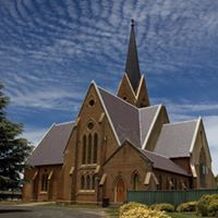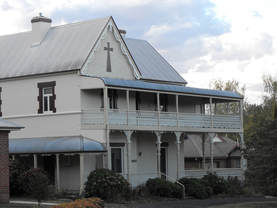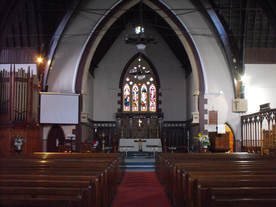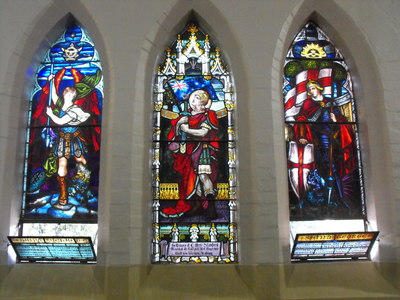
Holy Trinity Orange is one of 34 Parishes in the Anglican Diocese of Bathurst.
Anglican ministry to the Central West began in Carcoar in 1845. The first Rector made periodic visits to other centres. The first service for Anglicans in Orange (then Blackmans Swamp) was in 1846 at the Five Ways where the Congregational (now Uniting) church stands. Orange was proclaimed a village that year.
In June 1851, The Reverend Philip Agnew (Chaplain to Bishop Broughton of Sydney) officiated under a tree in the encampment at Ophir which was attended by 500 people. Between 1851 and 1855 he maintained a monthly ministry to Orange.
In October 1855 Bishop Barker of Sydney, confirmed a number of people in the Orange Court House. A plaque commemorating his visit can be found on the verandah of the old Court House. It was reported that year that there were 1200 members of the Church of England in Orange.
A public meeting decided that the house be built for a resident clergyman. A Building Committee was appointed and in 1856 the first Rectory was built, a timber residence next to the Bluestone Hall.

Bluestone Hall
In August 1856 a committee was appointed to construct a place of worship. In July 1857 the foundation stone for a church was laid by William Dale. The Bluestone Hall was opened in January 1858 and is now known as the Bluestone Hall. The Bluestone Hall served for a time as Holy Trinity Grammar School.
One of the people baptised during the period was well known Australian poet, Andrew Barton (Banjo) Paterson. The Bluestone Hall was sold in 2017.
In August 1856 a committee was appointed to construct a place of worship. In July 1857 the foundation stone for a church was laid by William Dale. The Bluestone Hall was opened in January 1858 and is now known as the Bluestone Hall. The Bluestone Hall served for a time as Holy Trinity Grammar School.
One of the people baptised during the period was well known Australian poet, Andrew Barton (Banjo) Paterson. The Bluestone Hall was sold in 2017.
Trinity Grammar 1924-1952
Trinity Grammar School, founded in 1924, commenced classes in the Bluestone Hall.
Orange Anglican Grammar School commenced operations in January 2007 in the Holy Trinity Memorial Hall, next to the original Trinity Grammar of the 20th century before moving to Murphy Lane on a 10 hectare site on the north west fringe of Orange.
Trinity Grammar School, founded in 1924, commenced classes in the Bluestone Hall.
Orange Anglican Grammar School commenced operations in January 2007 in the Holy Trinity Memorial Hall, next to the original Trinity Grammar of the 20th century before moving to Murphy Lane on a 10 hectare site on the north west fringe of Orange.

The Rectory
The Rectory dates from about 1865. The second-storey balcony was added after 1909. The original shingle roof can be found underneath the corrugated iron roof.
The Rectory dates from about 1865. The second-storey balcony was added after 1909. The original shingle roof can be found underneath the corrugated iron roof.

The Present Church
Opened on August 24, 1879, the present church building was designed by Sydney architect, Thomas Rowe. At the cost of 7,000 pounds, it was designed to seat 600. It was described as "a large high Victorian Gothic revival brick church" of "cruciform plan with steep slate roof and prominent tower and spire on the southern side", and holds a prominent position in the center of Orange.
The 1928 publication Orange and District Illustrated comments that "Unfortunately the structure was left unfinished, and the debt with added interest imposed almost entirely on the guarantors and others in the parish to pay off".
Canon H. Walker-Taylor (1909 -1927) was able to have the debt paid off to permit consecration of the Church by St Lukes Day, October 18, 1909.
2005 saw the creation of the Trinity Foundation with the aim to raise funds through The National Trust of Australia (NSW) Holy Trinity Church Conservation Appeal to assist with the restoration of the Church building.
Francis Bertie Boyce was the Rector during the 1870's. Under his leadership churches were constructed at Borenore, March, Caves Creek, Canobolas and Springside.
Opened on August 24, 1879, the present church building was designed by Sydney architect, Thomas Rowe. At the cost of 7,000 pounds, it was designed to seat 600. It was described as "a large high Victorian Gothic revival brick church" of "cruciform plan with steep slate roof and prominent tower and spire on the southern side", and holds a prominent position in the center of Orange.
The 1928 publication Orange and District Illustrated comments that "Unfortunately the structure was left unfinished, and the debt with added interest imposed almost entirely on the guarantors and others in the parish to pay off".
Canon H. Walker-Taylor (1909 -1927) was able to have the debt paid off to permit consecration of the Church by St Lukes Day, October 18, 1909.
2005 saw the creation of the Trinity Foundation with the aim to raise funds through The National Trust of Australia (NSW) Holy Trinity Church Conservation Appeal to assist with the restoration of the Church building.
Francis Bertie Boyce was the Rector during the 1870's. Under his leadership churches were constructed at Borenore, March, Caves Creek, Canobolas and Springside.
Christ Church Borenore
Christ Church Borenore was built by the combined effort of the Methodist, Church of England and the Presbyterian congregations, and was completed in 1878 and consecrated in 1995. It was originally called Christs Church as it was not seen by the local folk as belonging to any one denomination but as a shared place of worship for all. They all contributed to the supply, transport and construction of both the Church and the adjacent school. All materials used were obtained locally: clay for the bricks from nearby Borenore Creek (and were fired in a hired mobile kiln), large timbers from Mount Canobolas, and shingles cut from a reserve several miles to the east.
The white marble font was crafted from marble quarried near Borenore Caves by Mr Rusconi, an Italian immigrant. Most of the wooden furniture was made locally. Several of the stained glass windows were made by the late Philip Handel.
Services were conducted by all three denominations until after World War 2.
Christ Church Borenore was sold in 2020.
Christ Church Borenore was built by the combined effort of the Methodist, Church of England and the Presbyterian congregations, and was completed in 1878 and consecrated in 1995. It was originally called Christs Church as it was not seen by the local folk as belonging to any one denomination but as a shared place of worship for all. They all contributed to the supply, transport and construction of both the Church and the adjacent school. All materials used were obtained locally: clay for the bricks from nearby Borenore Creek (and were fired in a hired mobile kiln), large timbers from Mount Canobolas, and shingles cut from a reserve several miles to the east.
The white marble font was crafted from marble quarried near Borenore Caves by Mr Rusconi, an Italian immigrant. Most of the wooden furniture was made locally. Several of the stained glass windows were made by the late Philip Handel.
Services were conducted by all three denominations until after World War 2.
Christ Church Borenore was sold in 2020.

Memorial Tower
On August 3rd, 1919 the Church bell tower was dedicated as a Memorial Tower. Laid by R Rev'd Bishop G M Long DD LLD ,the inscription reads:
"To the glory of God and in memory of the soldiers and sailors who fought in the Great War 1914-1918"
Within the Memorial Tower Porch hang the Great War Memorial Honour Roll and Colours of the 6th Light Horse Regiment.
The installation of the ring of 8 bells was completed in 2007.
More information on the bells can be found on the Bell Ringing page.
On August 3rd, 1919 the Church bell tower was dedicated as a Memorial Tower. Laid by R Rev'd Bishop G M Long DD LLD ,the inscription reads:
"To the glory of God and in memory of the soldiers and sailors who fought in the Great War 1914-1918"
Within the Memorial Tower Porch hang the Great War Memorial Honour Roll and Colours of the 6th Light Horse Regiment.
The installation of the ring of 8 bells was completed in 2007.
More information on the bells can be found on the Bell Ringing page.

Organ
The pipe organ, was originally built in 1911 by the British Pianoforte Deport Ltd and dedicated on January 23, 1913 in memory of Bishop Camidge who died in 1911. It was rebuilt, in celebration of 100 years of Anglican teaching in Orange, in 1955.
The pipe organ, was originally built in 1911 by the British Pianoforte Deport Ltd and dedicated on January 23, 1913 in memory of Bishop Camidge who died in 1911. It was rebuilt, in celebration of 100 years of Anglican teaching in Orange, in 1955.
Other Buildings
Holy Trinity continued to grow with the addition of further buildings
Holy Trinity continued to grow with the addition of further buildings

A Sunday School Hall was built in the 1950s.
- This was converted to the Parish Centre in 1993.
- At the rear of the building is the Columbarium , two remembrance niche walls. More information on the Columbarium.

The World War II Memorial Hall
Opened on 2nd July 1967, the Orange Anglican Grammar School held classes here until 2009.
The Parish Centre moved to the Memorial Hall in 2018 as a larger space was required.
Opened on 2nd July 1967, the Orange Anglican Grammar School held classes here until 2009.
The Parish Centre moved to the Memorial Hall in 2018 as a larger space was required.

Retirement Village
Opened in 1995 the village has nine self contained units for independent living.
More information can be found on the Retirement Village page.
Opened in 1995 the village has nine self contained units for independent living.
More information can be found on the Retirement Village page.

Parish Rectors
A plaque is located in the Church with the names and dates of Parish Rectors, formed in 1857.
KING A. SMYTHE 1857 - 1858
MAYNE R. H. 1858 - 1865
INNES G.A.C. 1865 - 1867
FLETCHER T. 1867 - 1869
LANGLEY HENRY A. 1869 - 1871
GARDINER A. W. 1871 - 1875
BOYCE F.B. 1875 - 1881
DUNSTAN C. C. 1881 - 1895
TAYLOR T. LINTOTT 1895 - 1909
TAYLOR H. WALKER 1909 - 1928
NEEDHAM H. S. 1928 - 1937
POLAIN G. 1937 - 1941
HALLIDAY A. G. 1941 - 1952
SMEE GORDON H. 1952 - 1968
RICH C. WILLIAM 1969 - 1972
KEMPSON NORMAN C. 1973 - 1983
THOMAS ALAN 1983-1987
KEMPSON NORMAN C. 1987 - 1990
GOFF BRIAN E. 1991 - 1999
HETHERINGTON F. W. 1999 - 2014
DUNNETT M. 2014 -2022
A plaque is located in the Church with the names and dates of Parish Rectors, formed in 1857.
KING A. SMYTHE 1857 - 1858
MAYNE R. H. 1858 - 1865
INNES G.A.C. 1865 - 1867
FLETCHER T. 1867 - 1869
LANGLEY HENRY A. 1869 - 1871
GARDINER A. W. 1871 - 1875
BOYCE F.B. 1875 - 1881
DUNSTAN C. C. 1881 - 1895
TAYLOR T. LINTOTT 1895 - 1909
TAYLOR H. WALKER 1909 - 1928
NEEDHAM H. S. 1928 - 1937
POLAIN G. 1937 - 1941
HALLIDAY A. G. 1941 - 1952
SMEE GORDON H. 1952 - 1968
RICH C. WILLIAM 1969 - 1972
KEMPSON NORMAN C. 1973 - 1983
THOMAS ALAN 1983-1987
KEMPSON NORMAN C. 1987 - 1990
GOFF BRIAN E. 1991 - 1999
HETHERINGTON F. W. 1999 - 2014
DUNNETT M. 2014 -2022
Proudly powered by Weebly






